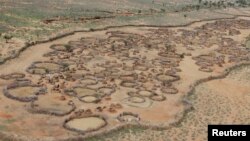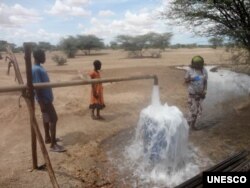NAIROBI —
Satellite technology has revealed that the drought-stricken Turkana region of northern Kenya lies atop two giant underground lakes, or aquifers. Estimates indicate the finds could solve the barren region's water problems and provide all of Kenya with enough water for the next 70 years.
The government of Kenya and the U.N. agency UNESCO on Wednesday announced huge new water finds in one of the most arid parts of the country.
Kenya’s minister of environment, water and natural resources, Judi Wakhungu, said the two aquifers in Turkana -- a northern region long mired in poverty and conflict from a lack of water -- could not only transform the lives of local communities, but also the country.
“What we found in Turkana basin and Lotipiki basin is very exciting because it’s over 200 billion cubic meters of water," she said. "This means that if we use this water sustainably we will have enough water for the next two generations.”
Exploration company Radar Technologies International found the underground lakes using satellite technology.
RTI’s General Manager Alain Gachet said that the huge estimates could be the tip of the iceberg.
“It’s a complex model but we based our estimation only on the superficial, on the first 300 meters," he said. "And the lake is one-and-a-half kilometers deep, maybe completely soaked with water. So I consider we were very conservative with these reserves, as we considered only the first 300 meters.”
Gachet says the resource could turn pastoralists from beggars embroiled in cross-border water conflicts with South Sudan and Uganda into potential thriving and peaceful communities able to grow their own food.
That would be welcome news to residents of Turkana, where the malnutrition rates can soar as high as 37 percent.
Gachet admits that there could be some environmental damage to the area, but that people came first.
“You know, when people are dying of thirst, you don’t think of the environmental impact, besides the fact that you are going to give water to these people and their cattle," he said. "The first impact is positive. So for sure, better have water than no water.”
Gretchen Kalonji, assistant director-general for natural sciences at UNESCO, which protects areas of scientific and natural interest, also stressed the human need.
“It’s an area which as you know is extremely short in water and you know, it witnessed the worst drought in 60 years in 2011, where I think 12 million people ended up displaced, and a large number fo people ended up dying, so that’s important to keep in mind,” she said.
Wakhungu said the find was “historic” as for the first time, the people of Turkana would have clean drinking water. She said the reserves could completely transform the lives of people there, first through agriculture and then industrial production.
“If managed well, it means the notion of drought, the notion of lack of water, is now history for the Turkana people,” she said.
Unlike the water in Lake Turkana, which has higher levels of alkaline, the underground water is drinkable, and Wahungu said that local communities would be able to start drinking it within a month.
Wakhungu said the search for water will soon go nationwide in the hope that other areas suffering water shortages, such as the Kenyan coast, might soon turn from dustbowls into breadbaskets.
“We are so encouraged by this technology that we are now going to roll this out and do a groundwater mapping exercise for the whole country,” she said.
In a continent where the fear of “water wars” is strong, Gachet also hopes that his technology can keep the peace.
His mantra is “a little water is war, a lot of water is peace, as you can share with neighbors."
The government of Kenya and the U.N. agency UNESCO on Wednesday announced huge new water finds in one of the most arid parts of the country.
Kenya’s minister of environment, water and natural resources, Judi Wakhungu, said the two aquifers in Turkana -- a northern region long mired in poverty and conflict from a lack of water -- could not only transform the lives of local communities, but also the country.
“What we found in Turkana basin and Lotipiki basin is very exciting because it’s over 200 billion cubic meters of water," she said. "This means that if we use this water sustainably we will have enough water for the next two generations.”
Exploration company Radar Technologies International found the underground lakes using satellite technology.
RTI’s General Manager Alain Gachet said that the huge estimates could be the tip of the iceberg.
“It’s a complex model but we based our estimation only on the superficial, on the first 300 meters," he said. "And the lake is one-and-a-half kilometers deep, maybe completely soaked with water. So I consider we were very conservative with these reserves, as we considered only the first 300 meters.”
Gachet says the resource could turn pastoralists from beggars embroiled in cross-border water conflicts with South Sudan and Uganda into potential thriving and peaceful communities able to grow their own food.
That would be welcome news to residents of Turkana, where the malnutrition rates can soar as high as 37 percent.
Gachet admits that there could be some environmental damage to the area, but that people came first.
“You know, when people are dying of thirst, you don’t think of the environmental impact, besides the fact that you are going to give water to these people and their cattle," he said. "The first impact is positive. So for sure, better have water than no water.”
Gretchen Kalonji, assistant director-general for natural sciences at UNESCO, which protects areas of scientific and natural interest, also stressed the human need.
“It’s an area which as you know is extremely short in water and you know, it witnessed the worst drought in 60 years in 2011, where I think 12 million people ended up displaced, and a large number fo people ended up dying, so that’s important to keep in mind,” she said.
Wakhungu said the find was “historic” as for the first time, the people of Turkana would have clean drinking water. She said the reserves could completely transform the lives of people there, first through agriculture and then industrial production.
“If managed well, it means the notion of drought, the notion of lack of water, is now history for the Turkana people,” she said.
Unlike the water in Lake Turkana, which has higher levels of alkaline, the underground water is drinkable, and Wahungu said that local communities would be able to start drinking it within a month.
Wakhungu said the search for water will soon go nationwide in the hope that other areas suffering water shortages, such as the Kenyan coast, might soon turn from dustbowls into breadbaskets.
“We are so encouraged by this technology that we are now going to roll this out and do a groundwater mapping exercise for the whole country,” she said.
In a continent where the fear of “water wars” is strong, Gachet also hopes that his technology can keep the peace.
His mantra is “a little water is war, a lot of water is peace, as you can share with neighbors."









